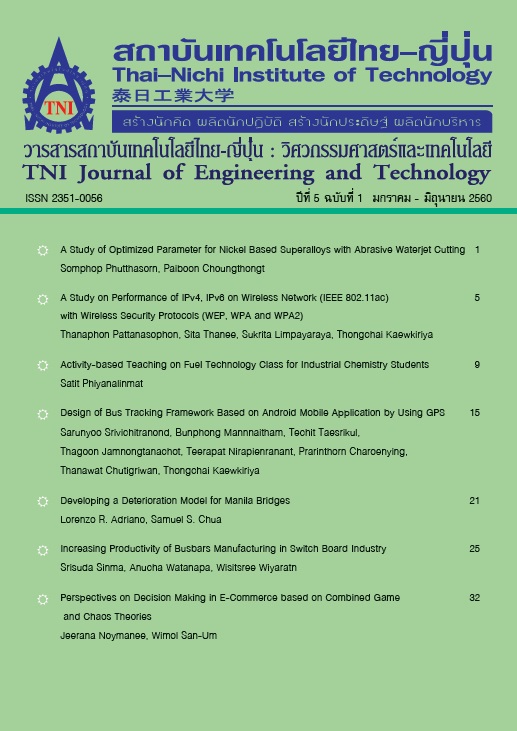A Study of Optimized Parameter for Nickel Based Superalloys with Abrasive Waterjet Cutting
Main Article Content
Abstract
The abrasive waterjet technology is a cutting process without heat. No smoke and toxic occurred during the cutting process. The cut surfaces of work pieces are clean and the quality is based on accordingly the configuration parameters. The research studies the cutting mechanism and optimized parameters for the cut surface quality. For reduce the loss of material and amount of abrasive garnet used in the process. The experiment will cut the Nickel based super alloys grade Inconel 718 thickness 6.35 mm. Design of experiment and determine the main parameters of cutting operation with Water pressure,
Abrasive flow rate and Traverse speed. The analysis of the results obtained has been performed by Taguchi method. In order to identify the process parameters that is significant in affecting with the taper angle. The analysis of variance (ANOVA) has been carried out to estimate the relative contribution of each control factor. The cutting results showed that parameters are affected with taper angle as a function of kinetic energy loading.
Article Details
Article Accepting Policy
The editorial board of Thai-Nichi Institute of Technology is pleased to receive articles from lecturers and experts in the fields of engineering and technology written in Thai or English. The academic work submitted for publication must not be published in any other publication before and must not be under consideration of other journal submissions. Therefore, those interested in participating in the dissemination of work and knowledge can submit their article to the editorial board for further submission to the screening committee to consider publishing in the journal. The articles that can be published include solely research articles. Interested persons can prepare their articles by reviewing recommendations for article authors.
Copyright infringement is solely the responsibility of the author(s) of the article. Articles that have been published must be screened and reviewed for quality from qualified experts approved by the editorial board.
The text that appears within each article published in this research journal is a personal opinion of each author, nothing related to Thai-Nichi Institute of Technology, and other faculty members in the institution in any way. Responsibilities and accuracy for the content of each article are owned by each author. If there is any mistake, each author will be responsible for his/her own article(s).
The editorial board reserves the right not to bring any content, views or comments of articles in the Journal of Thai-Nichi Institute of Technology to publish before receiving permission from the authorized author(s) in writing. The published work is the copyright of the Journal of Thai-Nichi Institute of Technology.
References
M. Zsolt, “Energy approach of the taper at abrasive waterjet cutting”, Production Processes and Systems, vol.6, pp. 89-96, 2013.
H. Louis, “Abrasive water jets”, in 5th Pacific rim International Conference on Water Jet Technology, New delhi, India, Feb 1998, pp. 321-329.
V. Gupta, P. M. Pandey, M. P. Garg, R. Khanna, and N. K. Batra, “Minimization of Kerf Taper Angle and Kerf Width Using Taguchi’s Method in Abrasive Water Jet Machining of Marble,” Procedia Materials Science, vol. 6, pp. 140–149, Jan. 2014.
J. Wang, “A machinability study of polymer matrix composites using abrasive waterjet cutting technology,” Journal of Materials Processing Technology, vol. 94, no. 1, pp. 30–35, Sep. 1999.
D. Arola and M. Ramulu, “A Study of Kerf Characteristics in Abrasive Waterjet Machining of Graphite/Epoxy Composite,” J. Eng. Mater. Technol, vol. 118, no. 2, pp. 256–265, Apr. 1996

